Please use the following link to download the May 3, 2025 issue of the syəcəb
Category: Tulalip News
Earth Day every day
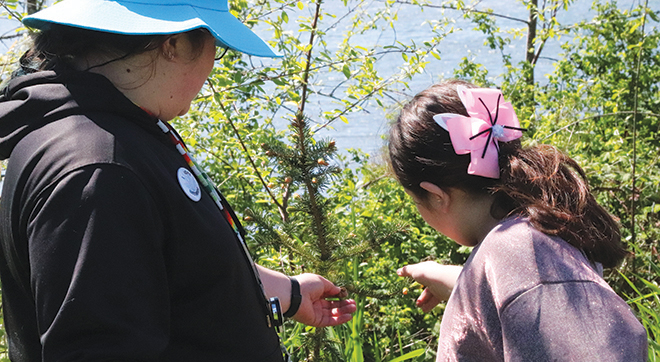
By Wade Sheldon, Tulalip News
Approximately 20 percent of the Tulalip Reservation comprises wetlands—natural systems that help prevent flooding, filter contaminants from water sources, and provide vital habitat and spawning grounds for salmon native to the Salish Sea. These ecosystems play a crucial role in both environmental health and cultural preservation.
Cleansing Mother Earth and empowering tribal members to protect their homelands for future generations has never been more urgent. On Tuesday, April 22, Tulalip’s Earth Day Celebration brought the community together for a day of learning, restoration, and stewardship across several locations on the reservation.
At the Tulalip Health Clinic, participants revitalized the community garden by repurposing raised beds and transplanting plants grown for giveaways, including calendula, a healing herb often used to make salves. Meanwhile, community members gathered at Mission Beach to remove debris along the shoreline, while others participated in a cleanup effort along 27th Avenue near Heritage High School.
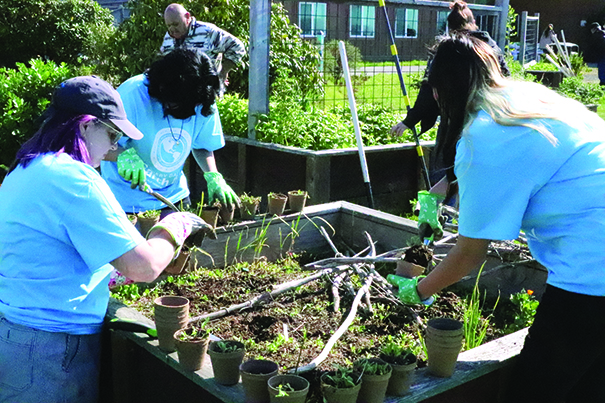
A guided plant walk took place around the ballfield behind the Youth Center, educating attendees about the reservation’s wetlands. Booths were also set up at the Youth Center, offering tips on nutrition, home renovation, gardening, and recycling. Creative and sustainable living ideas were introduced, such as using hempcrete—a bio-composite building material made from hemp—to construct affordable homes. Tulalip is set to become one of the first tribal communities to build a hempcrete house in collaboration with the Indigenous Habitat Institute later this year.
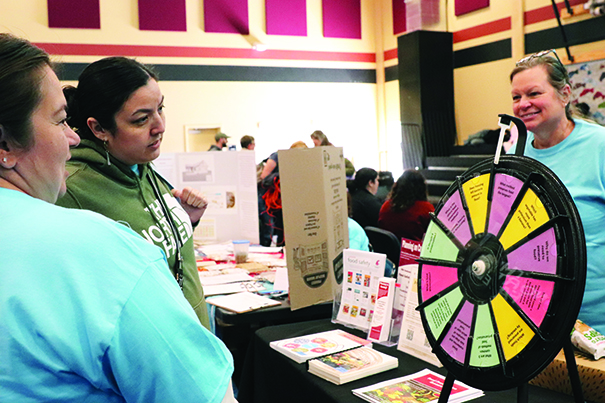
Other booths shared exciting initiatives. TERO provided information about solar panel installation programs available to Tulalip residents. Knox Cellars encouraged families to support pollinator populations by raising backyard beehives. At a fruit nutrition station, attendees could spin a prize wheel to win fruit and learn about healthy eating.
Tribal member Joyia Kinlicheeney was among those who came out to support the Mission Beach cleanup. As garbage bags were handed out and participants began making their way toward the shore, Joyia cheered, “And it starts!”—capturing the day’s spirit.
Michelle Bahnick, Wetland Biologist with Tulalip Natural Resources, led the plant walk and shared her expertise on local plant species. When the group reached the first wetland, Bahnick asked if anyone could identify a plant. A young girl excitedly called out, “Cattails!” Bahnick confirmed and explained their dual role. While cattails filter pollutants and provide habitat, their aggressive growth can threaten biodiversity by overtaking native species.
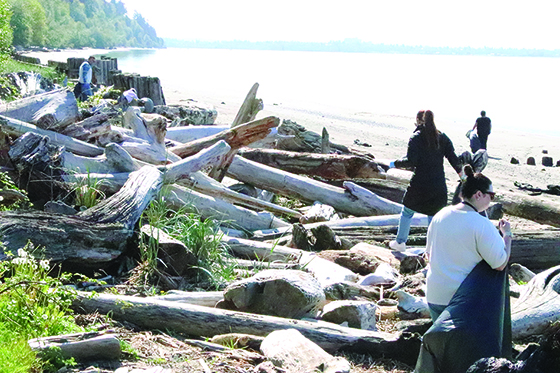
“We have excellent stormwater developments, but it’s nothing compared to what nature can do,” Bahnick said. She pointed to the wetlands surrounding the ballfield as an ecological restoration site. “If you impact an environmentally sensitive area, you become responsible for offsetting those impacts,” she noted, referring to replanting efforts that have taken place near the Youth Center.
Environmental Education and Outreach Coordinator Melissa Gobin spoke passionately about fostering a deeper connection between the community and the land. “I want them to love the land like I love it. I want them to take care of this land and take pride in it. I don’t want people coming here and throwing garbage everywhere. This is where we all have to live, and we need to act as a community. I want them to love it like it’s their mother.”
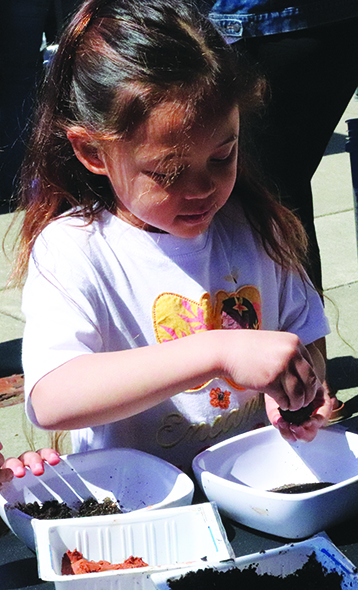
She also sees youth education as the key to lasting change. “Teaching kids through outreach education is what I think will get people more passionate about caring for the land—it’s contagious,” she said.
Gobin warned that neglecting the land will bring severe consequences. “If we don’t care for Mother Earth, she will fight back. You can expect a polluted environment where fish could become extinct, and animals will have nowhere to live. The water will be polluted, the air will suffer, and climate change will worsen. We’re already seeing these effects and need to act to prevent further damage.”
When speaking on how all those who came out took away from today, she hopes participants walked away feeling inspired and empowered. “I want them to develop a love for nature, to get their hands in the dirt and truly appreciate what Mother Earth provides. They should feel empowered to grow one plant or start a garden. They can volunteer and learn about important restoration projects for salmon, bees, and other pollinators. It’s all connected, forming one huge cycle of life that we must protect.”
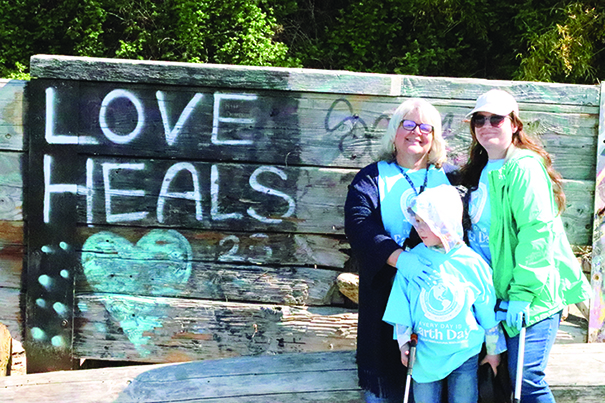
Tulalip’s Earth Day celebration served as a reminder that environmental responsibility doesn’t begin and end with a single day- it’s a continuous commitment rooted in culture, community, and care for the land. From restoring gardens to learning about native plants and sustainable building, every action taken reflects a growing movement toward harmony with nature. As more people participate in these efforts, the hope is that Earth Day becomes more than a date on the calendar- it becomes a way of life. Let every day be Earth Day.
Mel Sheldon receives Elson S. Floyd Award for visionary leadership
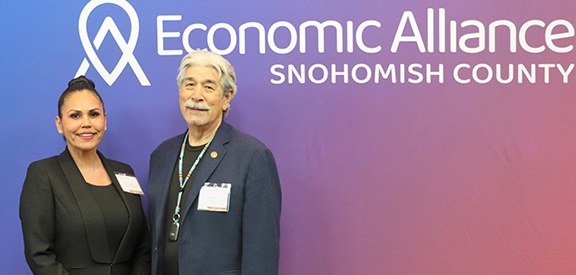
By Micheal Rios, Tulalip News
Economic Alliance Snohomish County recently held its annual meeting and award ceremony within the always stylish Orca Ballroom, the Tulalip Resort’s largest banquet hall. Economic Alliance events are where locally elected politicians, business owners, and decision-makers gather to network and receive updates that impact the economic well-being and vitality of Snohomish County.
During the annual meeting, two inspirational Tulalips were propelled front and center on the podium. One was T.G.O. President Marci Fryberg when she presented the John M. Fluke Award, which recognizes individuals who demonstrate an entrepreneurial spirit and community leadership.
“On behalf of our tribal community, we welcome you to our homelands today as we partner with the Economic Alliance Snohomish County in acknowledgement of all the good work happening within our communities that we serve,” said Marci to the members of Economic Alliance and invited guests before presenting the award to Craig Skotdal of Skotdal Real Estate. His family and company have played a critical role in shaping the development of downtown Everett, including bringing much-need housing to the area.
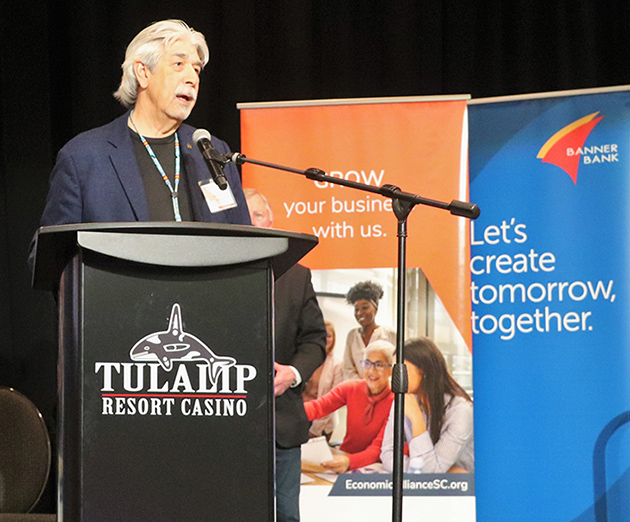
The second Tulalip to grace the podium was none other than Mel Sheldon when he received the Elson S. Floyd Award. An award that recognizes a visionary leader who through partnership, tenacity, and a strong commitment to community has created lasting opportunities to improve quality of life and positively impact the regional economy.
Mel served on the Tulalip Tribes Board of Directors for two decades, before retiring to the serenity of his motorcycle and fishing boat. Along with his fellow Board members, Mel helped to lead economic development efforts at Tulalip, including the construction of the Tulalip Resort Casino – one of the largest employers in Snohomish County – and the first-ever federally chartered tribal city in the United States, Quil Ceda Village.
Under his and the Board’s leadership, the Tulalip has initiated major transportation and infrastructure projects and built a strong police department and tribal court. They also completed important environmental restoration projects and created strong partnerships with other community leaders and organizations.
“The Elson S. Floyd Award honors an individual whose work exemplifies his legacy – bold vision, tireless dedication, and a belief in the power of partnership to transform lives. This year’s recipient is Mel Sheldon,” said Dr. Paul Pitre, Chancellor for Washington State University’s Everett campus.
“A longtime leader of the Tulalip Tribes and a respected figure across Everett, Marysville and the broader Puget Sound region, Mel has been a unifying force, bringing together people across sectors, across cultures, and across communities,” described Dr. Pitre. “He leads with humility and purpose and his impact is felt in every corner of our great region.
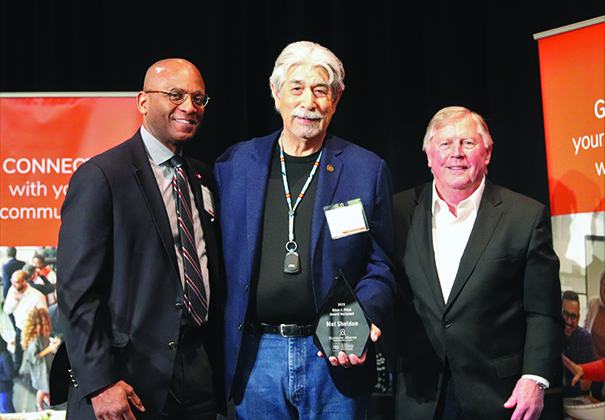
“From supporting education programs and job creation to promoting tourism and economic vitality, Mel has worked to ensure that growth is sustainable and inclusive. Proof that lifting up community goes far beyond just good leadership, it’s about lasting legacy. He has opened doors and built bridges by strengthening relationships between tribal and non-tribal partners, and creating new pathways for progress throughout Snohomish County. Mel Sheldon reminds us that leadership is not only standing at the front, it’s about showing up again and again for your people, for your neighbors, and for your future.”
An active and engaged leader not just in Tulalip, but all of Snohomish County, Mel served in many capacities, including on the boards of Providence Hospital Foundation, Citizens Committee for Marysville Schools, and the Boys and Girls Club of Snohomish County. He also worked diligently on behalf of the larger Native American population when he served as alternate vice-president for the National Congress of American Indians (NCAI) northwest region. Last, but certainly not least, Mel also served as vice president in the Affiliated Tribes of Northwest Indians (ATNI), an association representing nearly 50 tribes.
After accepting the Elson S. Floyd award for his visionary leadership, Mel shared that what he’s most proud of is the development of the economic powerhouse that Tulalip has become. He also acknowledged that while much has been achieved, there is still more work to do.
“When I first got on Tribal Council twenty-four years ago, we had nothing but dirt, trees, and dreams. Now, we have the gaming properties and Quil Ceda Village, and all the businesses we’ve attracted there. It’s helped Snohomish County and the Tulalip Reservation work together, grow together, and become not just a destination, but a desirable place where people want to live. I stand here today humbled, so honored, and eager to see the future growth of the Reservation and our County.”
Blowing Bubbles for Autism
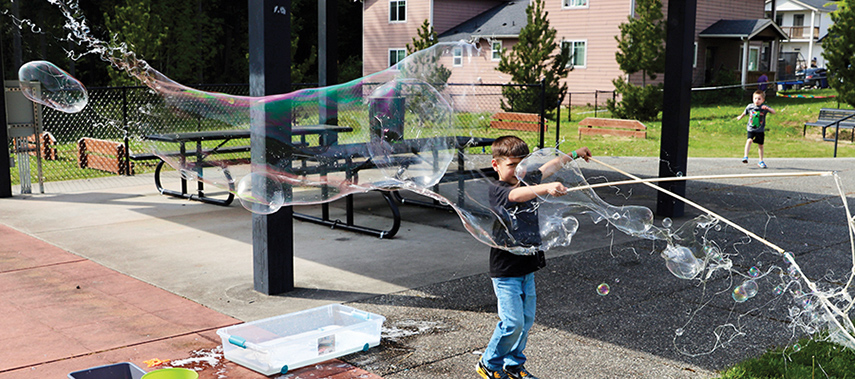
By Kalvin Valdillez, Tulalip News
“Bubbles!” exclaimed 7-year-old Zy’ani Johnson as countless bubbles caught in the wind and blew all about the Mission Highlands playground. While she watched a particularly big bubble fly away, young Marcus James chased it down. As it lifted high into the air, he reached it at the last second. Laughing with joy, he jumped into the sky with his index finger extended and popped it before it could get away. Returning to the bubble station, exuding jubilation and confidence from the adults cheering him on, Zy’ani welcomed him back and said, “Pop! Pop! Pop!”
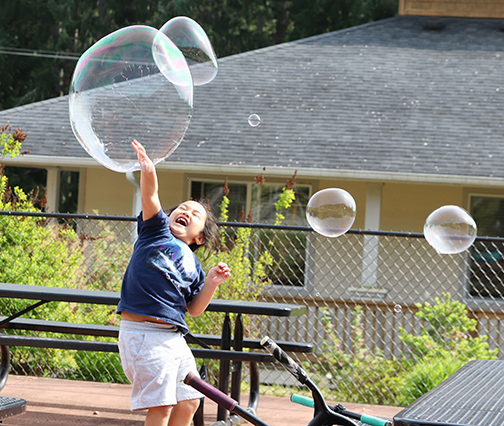
This bubble extravaganza, organized by Tulalip Family Haven’s Intellectual Developmental Disability Support program (IDD), took place on April 25 and was certainly heartwarming and one for the books. Held in celebration of Autism Acceptance Month, the springtime get-together brought smiles to dozens of local kids either diagnosed with an Autism Spectrum Disorder, or those who are in the process of receiving a diagnosis.
What made the event all the more special, was the fact that the bubble station was completely homemade, which allowed for some great interaction between the parents, kiddos, and the IDD team. Caseworkers, Alayna Helland and Talia Franza did their research and made numerous giant bubble wands simply from dowels and rope in anticipation of gathering.
When the families arrived, they got the chance to teach them how to use the bubble wands, making it a hands-on and sensory-satisfying occasion for the children. Evidenced by the happiness and gleeful expressions on their faces, the kids had a blast creating their own bubbles, which made for a much more memorable and fun experience than it would’ve if the IDD program decided to hire a bubble professional.
Still in its early years of infancy, the IDD program has done good work for Tribal families since its inception two years ago. Nationally, autism is becoming more prevalent in households across the country. According to the Centers for Disease Control and Prevention (CDC), one in thirty-six children in the United States are diagnosed with an ASD.
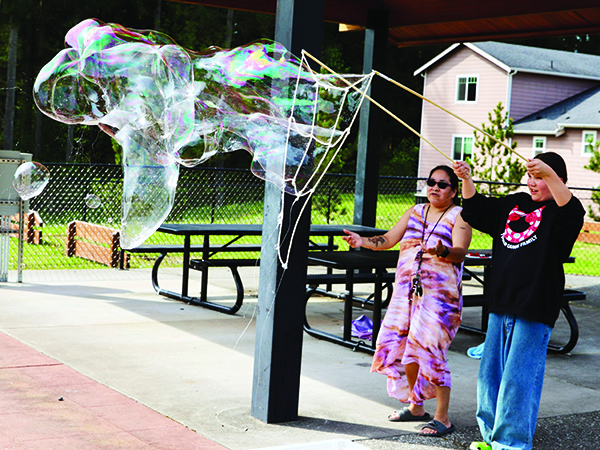
Though this statistic could be considered across the board for all races and nationalities, it could also be a little misleading when it comes to children living on reservations. This is due to a general lack of resources and information available to tribal families throughout the nation. While most kids living with ASD or IDD receive their diagnosis by the age of three, Indigenous youth often don’t get an official diagnosis until middle childhood or preadolescence.
This can be overwhelming for tribal families. Without receiving that diagnosis, which is a daunting process on its own, those families don’t have access to tools and resources that are helpful and fundamentally necessary during their kiddo’s early childhood years. The IDD program was established to help bridge that gap between the reservation and those resources.
The program is referral-based and takes both outside referrals, from other tribal programs and/or the Marysville School District, as well as self-referrals where a family can request services by either in-person appointments or by completing an online application on Family Haven’s tribal department webpage. They offer their services to Tulalip tribal members as well as to other Natives who live in Snohomish County. IDD services include monthly play groups, weekly support groups, community outreach, connecting families with resources, and assistance with any applications in regard to their child’s needs such as medical, disability, and caregiving.
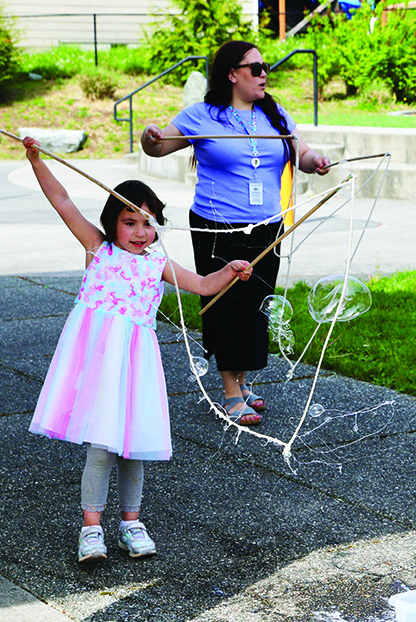
The Autism Acceptance Month bubble event encompassed all of these services in one. Inside the Mission Highlands building, there was a resource booth filled with all the necessary paperwork and informational flyers for the families to learn more about the program and how they can assist their kids throughout their journey. Most importantly, the gathering allowed families the chance to get to know each other, and also for the youngins to socialize together while engaging in bubble play. This has been proven to be impactful for kids with autism and their brain development and cognitive function because of its emphasis on patience, perception, creativity, sensory integration, visual tracking, hand-eye coordination, cause and effect, social interaction/skills, and motor skills.
While her son, Marcus, made his way back and forth from the playground to the bubble station, Yulia James shared, “I wanted for him to have fun and be around kids his age, make new friends. He is an only child, so I wanted him to get to know everybody and other people besides just his relatives. My son is not diagnosed with autism yet, we are still waiting on the diagnosis. But Alayna has helped me with everything and helped us go through all the channels. This is good to see – that he likes to have fun with different kids. I would love for more events like these to happen more often.”
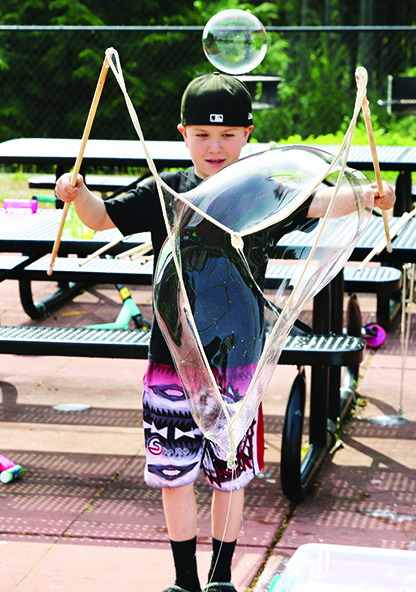
As his daughters Zy’ani and Anirrah, were fully immersed in that bubble life, Quincy Johnson expressed, “Both of my daughters have autism, so we were looking for programs to help us out. This is still fairly new to me, Zy’ani is seven and was diagnosed two years ago and I’m still getting my youngest diagnosed. I’m still learning and figuring stuff out as I go. I can honestly say Family Haven is a blessing. They helped with resources and support because I didn’t know where to start. And today – I just love it. I feel like there needs to be more events like this for kids with autism. I didn’t know how they were going to act around other kids, but they’re doing fine. They love bubbles. They’re loving it, so I’m loving it too. What Family Haven is doing is wonderful and I’m so thankful for them.”
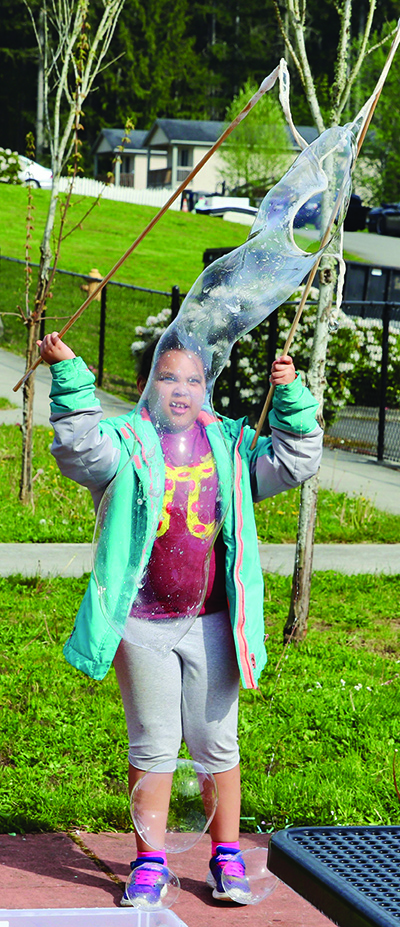
The two-hour bubble bash was a success and has many families looking forward to more group play and events.
Said Alayna, “Today felt really good. The kids really took to the bubbles and the adults too. We had a lot of sensory stuff going on, the bubble play, and sidewalk chalk, and just being outside. We always try to have a sensory-based activity to keep the kids busy and interested and it seemed to really work out today. A lot of our parents feel secluded at home because kids who are autistic, they have their quirks and their ticks and there are different things about them. I feel that when we have events like this, they can be accepted for who they are. And it feels good to provide a space where they can be themselves, have fun, and be happy.”
For more details about the IDD program, please contact (360) 716-4935.
April 26, 2025 syəcəb
Please use the following link to download the April 26, 2025 issue of the syəcəb
5th Annual Easter Bunny Run delivers treats and smiles to Tulalip

By Kalvin Valdillez, Tulalip News
“Easter Bunny, will you hop with me?” asked a young Tribal member on the afternoon of April 19. Once her request was met with a head nodding yes from an Easter Bunny standing over 6 feet tall, she shrieked with joy and began jumping up and down with the bunny. This heartwarming moment was met with a resounding ‘aww’ from the multiple volunteers of the 2025 Easter Bunny Run, which included members of the local nonprofit organization, Together We’re Better, and the Tulalip Bay Fire Department.

The ‘hop along’ was a popular request by many children at this year’s event. And after the third or fourth time the bunny was called upon to hop with the kiddos, Together We’re Better Founder, Malory Simpson, exclaimed “This is why we do this. This is what it’s all about.”

Born out of a desire to bring back a sense of normalcy to children on the reservation, Together We’re Better organized the very first Easter Bunny Run during the pandemic. At the time, Malory explained that the nonprofit usually held an egg hunt for the community each year. However, with gathering restrictions in place, the nonprofit improvised and decided to bring Easter to the doorsteps of Tribal families.
The Easter Bunny Run was such a great success, that they decided to make it an annual springtime tradition. This was the fifth year the event was held and is something the community looks forward to every Easter. Not only is it a highlight for the kids, but the parents also match their children’s eagerness to greet the bunny and always have their phones out, ready to snap a pic with the loveable character.

Together We’re Better originally drew inspiration from the Tulalip Bay Fire Department’s annual Santa Run, in which Saint Nick visits all the neighborhoods within the station’s jurisdiction. The foundation reached out to the fire department to see if they wanted to participate in the event during the first run, and ever since TBFD and their mascot Sparky the Dalmatian has joined in on the fun.

Said TBFD First Responder, Tara Conyers, “We feel the Easter Bunny Run is important because we always like to engage with the community. We like to show our support for any event. We want to let the community know that we’re here for them, because it is true that when you work together with your community and your neighbors, we are better. We take pride in getting to know our neighborhoods and our communities, and we don’t want everyone to just see us when we show up for an emergency. We want them to recognize our faces when we come to an emergency, because we’ve been to all these events, and they know that we’re here and we’re a safe place, and they can always come to us, even if it’s not an emergency. We love seeing all the kids, and also all the adults start acting like kids again. It’s fun seeing everyone laughing and smiling.”

This year, unfortunately, Sparky couldn’t make the trip to Tulalip due to a scheduling conflict. But a few members of the firehouse were able to attend in his place. The Easter Bunny held the Run down solo and got the kids hyped up as he passed out sugary treats, easter eggs, and toys at numerous playgrounds in Tulalip’s housing developments.
Together We’re Better’s own Natosha Gobin shared, “The Together We’re Better events are so much fun to participate in because it is community driven. For the Easter Run, a lot of community members look forward to stuffing eggs, buying snacks, and doing whatever they can to help. It’s nice to take time and visit with the families and go to all the different developments. It feels so good to be with the community for a positive reason and to see how much this means to the families as a whole.”

Malory expressed, “Giving back to the community always feels good. This is all community effort; it makes my heart happy to see the community coming together to take care of each other. I just love it. The smiles and laughter make you feel really good inside. Just seeing the kids get excited is one of the best things about the event. It’s pretty fun to see all of their reactions and see how happy the kids are to spend some time with the Easter Bunny.”

If you are looking to get more involved with the community, Together We’re Better is always accepting donations, whether that is goods, funds, or your personal volunteered time. And it’s important to note that they are resurrecting one of their more popular events, the monthly Community Potluck, with their first get together scheduled for Saturday, May 17 at 3:00 p.m. For more information, please contact Malory Simpson at (425) 905-9137 or Natosha Gobin at (425) 319-4416.
Basket weaving bliss

By Wade Sheldon, Tulalip News
As Easter approached, community members chose to unite in a unique way. They came together not to create traditional Easter baskets but to skillfully weave cedar baskets instead. This twist on a holiday classic brought a fresh spirit of creativity and community.
On Saturday, April 19, the Hibulb Cultural Center welcomed Master Weaver Jamie Sheldon, an experienced instructor who has taught basket weaving there for over 10 years, to lead an engaging class. Eleven community members participated in creating what Jamie calls a “quarter basket.” A three-by-three-by-three-inch basket is utilized for storing small items and decorations.

Jamie showcased her cedar kits from her recent harvest, highlighting her passion for crafting. “We use all-natural materials for our baskets,” she said. “I traveled to the mountains to collect the rare yellow cedar central to our creations.”
Unlike the more common red cedar, yellow cedar grows mainly at mountain tops, making it valuable in basket weaving. Its beauty and rarity elevate the craftsmanship and reflect the spirit of the wild, with each basket telling a story of nature’s bounty and the artisan’s dedication.

The few who gathered to dedicate a few hours to learning a new craft shared laughs and enjoyed each other’s company. Among the attendees was Sarah McCord, who enthusiastically reflected on her experience: “I loved it. This was my first time attending a class at the Hibulb, and I truly appreciated the camaraderie. The instructor’s expertise was clear; she knew her stuff, and I learned so much.”
Almost everyone who attended finished their basket except one person, and Jamie said they could return to her Wednesday class to finish. The students who came to learn found great solace in their creations and held them up with pride after they finished.

Reflecting on her class and teaching at the Hibulb, Sheldon said. “It’s awesome teaching these classes, the people who aren’t Native that come to learn show a lot of respect and want to take in all that I teach.”
Participants left with their handcrafted baskets and a sense of accomplishment as the day ended. This gathering emphasized sharing skills and stories, fostering appreciation for the craft and natural materials. The spirit of collaboration highlighted the community’s heart, encouraging future exploration and creativity. Such experiences remind us that traditions can evolve, forging new bonds that enrich our cultural heritage.
If you’re interested in joining Jamie to create a cedar basket, she offers a class every Wednesday at 5 p.m. at the Hibulb Cultural Center.
Gearing up for a good journey

By Kalvin Valdillez, Tulalip News
The final landing for the 2025 Canoe Journey is set for July 31, with the weeklong protocol taking place at Elwha during the first week of August. The Tulalip Canoe family will join the journey mid-July and are determined to be ready for weeks of pulling, dancing, singing and fully immersing in the traditions of the Coast Salish tribes. The culture-sharing event has been going strong since its revival in 1989 and is popular amongst the youth of multiple tribes, helping them find a solid sense of identity by exposing them to their ancestral teachings.
Participation for the first week of Canoe Journey preparation was at an all-time high with upwards of 80 people showing up for Culture Night and Canoe Practice. Led by the Tulalip Rediscovery program, these two weekly events will be held throughout the next few months to ensure that this year’s Canoe Journey participants are well equipped to not only hit the water, but can also offer songs, dances, and gifts to the numerous tribes they will be visiting en route to Lower Elwha this summer and represent Tulalip in a good way.

Culture Night
There was a buzz in the air at the Tulalip Gathering Hall on the evening of April 15, as the people caught up with their friends and family over dinner before the night’s festivities began. After 30 minutes of laughter, conversation, and the little ones chasing each other about the hall, Natsha Fryberg and Taylor Henry of the Rediscovery Program opened the event with a few words and instruction for the first Culture Night gathering of the year.
The people were excited to get their craft on and start creating their regalia for this year’s Canoe Journey. Participants perused a number of tribal designs that included salmon, canoes, killer whales, and thunderbirds in traditional formline. With their design of choice in hand, each person received a pencil and tracing paper and began outlining their design onto the paper.

Once that task was complete, they picked out what color they wanted their design to be, between red, black, white, and gray and were handed fabric to iron their design on to. And finally, they were given X-ACTO knives and scissors to cut out their design, which will eventually be transferred on to either a shawl or vest.

While the adults and teens worked on their regalia, the kiddos joined Lushootseed instructor, Natosha Gobin for a language lesson. Keeping true to the Canoe Journey theme, Natosha taught the young ones the words for each section of the canoe. After practicing the words together, colored pencil sets were placed on the table and the kids got to design their very own canoes. While some chose their favorite vibrant and bright colors to spruce up their cedar canoes, many children chose to go with the classic black and red colors that adorn the Tulalip Family canoes, Little Sister, Big Sister, and Big Brother.
“We have a lot of different things planned for Culture Night,” shared Natasha Fryberg. “We will be sending out a schedule as to what we’re going to be doing. Each week we will be working with language and we will alternate between regalia making and then giveaway items for our journey to Elwha. I think that during those weeks we will sing and dance as well. I want to welcome everybody here. I hope even more of our community turns out and participates. This year, I really want it to be a thing where they are involved from the very beginning, and we continue on with a large canoe family.”

The Rediscovery Program will continue with Culture Nights on Tuesdays at 5:00 p.m. as the Paddle to Elwha approaches, so be sure to drop by if you are planning on joining the Paddle to Elwha.
Canoe Practice
After a long winter, the people of Tulalip were eager to get back on the canoe and reconnect to the Salish Sea. It was the perfect weather for the first Canoe Practice of the season on the afternoon of April 16. With clear skies, bright sunshine, and minimal wind, the participants were all smiles as they ran a few laps around the marina prior to breaking out their paddles.

The excitement grew as everyone jumped into the water to help unload Big Brother, the Canoe Family’s large cedar strip, from a trailer and welcome its spirit back to Tulalip Bay. Once Big Brother was on the water, the first crew boarded the canoe one by one, and put on lifejackets before striking the water in unison with their paddles and launching out into the Bay.
The course was set for Hermosa and back. While the pullers made their way through the local waters, they were met with a pleasant surprise. The mist spouting from two gray whales in the vicinity could be seen from the docks of the marina, but Canoe Practice participants got an up close and personal look at the large mammals, enhancing the cultural experience and connection for everyone on the canoe.

As the first crew arrived back at the marina, they couldn’t wait to share the tale of the two whales with the other participants. Luckily, the whales decided to hang out in the bay a little while longer, and the second crew also got to witness the whales along their excursion as well.
“This is my third year pulling, so going back out on the water was pretty nice, got to feel the sacred connection again,” expressed Tribal youth, Maleia Kickingwoman. “The water was a little rough at the beginning but once we got towards Hermosa it got more calmer, and we got to cruise a bit. We saw two whales. It was pretty fun. We had some laughs and funny jokes out on the water.”
When asked if she would be attending this year’s Canoe Journey, Maleia enthusiastically replied, “Yes, I am! And I am excited about meeting new friends at Canoe Journey this year.”

To help build endurance for Canoe Journey, Canoe Practice is set for every Wednesday at 5:30 p.m., beginning with a run/walk before heading out on the water.
Said Tulalip Skipper, Natasha Fryberg, “Today was exciting. I think that the first practice can be nerve-wracking for people and many feel uneasy. We had some new participants, and they enjoyed being out there. And today was really just about talking to them and teaching them through the expectations and how to properly do things, so it’s all just a good teaching experience. Not only does it teach our community how to properly pull, but we always think about safety first and building the strength and endurance to go on these journeys, from one destination to the other. I’m excited for this year, it’s a blessing. There were whales out there and it was a beautiful day, and we had a great turnout.”
Inner artist runs amuck at 45th annual Art Festival

By Micheal Rios, Tulalip News
Run amuck. An idiom meaning to behave in an unrestrained manner. Perhaps, there’s no more heartwarming goal than that of a youth’s desire to run amuck. To be free from restraints and restrictions, free from limits and boundaries. Alas, that may not be the best route for success in the real world. But, and it’s a big BUT, a youth’s inner artist running amuck may be the best route for success at the Tulalip Tribes annual Art Festival.
The 2025 rendition of Tulalip’s art extravaganza marked 45 years of showcasing the free-flowing imaginations let loose via various mediums by tribal students of the Marysville School District. Held on the evening of April 17, hundreds of friends, families and community educators wandered through the makeshift gala that was the Don Hatch Youth Center.

“Our annual Art Festival is an opportunity for each Native student within the District to express themselves in a unique and creative way,” explained Deyamonta Diaz, positive youth development lead advocate. “All the work that goes on behind the scenes to make this event possible, it’s like an all-hands-on-deck effort, is so worth it for our community to witness the pride and joy every student puts into their art.
“Each year our expectations are surpassed because we receive hundreds and hundreds of submissions. For me, I look forward to seeing what new ways our kids find to express their Native culture or even developing their own way to retell a traditional story. There’s always something new and eye-catching that they come up with.”
For more than four decades now, Tulalip has dedicated an evening to empowering emerging creatives to let their inner artist run amuck. They are rewarded not just by having their completed works displayed for all to see, but the most heartwarming and eye-catching efforts are awarded 1st, 2nd, and 3rd place ribbons. Plus, all the bragging rights.

Such was the case with 1st grader Penelope Joseph. She radiated pure joy while leading Festival attendees to her four ribbon winning submissions. Her favorite creation was her supersized rainbow that depicted the majesty of sunray reflections following rainfall. “I like rainbows because they are pretty, and all the colors!” declared young Penelope.
Also, beaming with pride from his inner artist literally running amuck in custom made Prowler Version 42 sneakers was 7th grader Mason Madwell. His parents scurried behind him as he couldn’t wait to see if his mixed media submission won a ribbon. Sure enough, on his purple, pink and black colorway was a shimmering blue 1st place ribbon.

“My inspiration was Prowler Version 42 from the new Spider-Verse movie,” explained Mason. For the uninitiated, the next installment of the animated blockbuster Spider-Man will feature an alternate dimension Miles Morales from Earth-42, who will portray a villain known as Prowler. “Finding a pair of shoes similar to his, I hand-painted the Prowler’s colors onto them, got the same lace color that match his mask, and cut into the soles to install LED lights, just like what he’ll have in the movie.
“It’s really cool to get 1st place in the category,” continued Mason. “I feel like I spent my time well and the judges really understood what my design was. I just feel proud and have to thank my mom for helping me.”
Penelope, Mason, and their fellow student culture bearers were able to win 1st, 2nd or 3rd place, plus honorable mention, in a variety of artistic mediums. Categories included culture, drawing, painting, writing, mixed media, sculpture, digital art, and pure heart. The top four from each grade and category received a ceremonial ribbon recognizing their talents.

This year’s Festival received over 650 submissions, with the most popular category by far being painting. There were dozens of artists who showed off their diverse talents by submitting artwork in as many categories as they could. There are also artists who continue to evolve their artwork and challenge themselves each year to claim one of those coveted ribbons in different categories.
Twelfth grader Kaylikwa Fryberg had herself quite the championship run by wowing judges and Festival attendees with her wide-range of eye-popping creations. She wove a father and son matching wool tunic set for Culture, turned thought and emotion into ink on paper for Writing, used India ink to create depth of shade and shadows in recreating a memory from Ross Lake in Painting, and used her recently acquired skills from a Schack Art Center internship to make a wobbly bowl for Mixed Media.

“This bowl holds a special place for me because it was the first I’ve made,” shared Kaylikwa. “For the colors, I chose my sister’s favorite colors – purple and white. My favorite part about making it was being able to spin the heated-up glass really fast to get the floppy edges to take shape. That’s why it’s called a floppy bowl. I actually burned myself for the first time at the Schack Center while making it, but that only adds to the memories.”
Interwoven through many of the thought-provoking youth creations were both subtle and not so subtle tie-ins to ongoing social awareness campaigns, human rights issues and demands for a sustainable future. From artistic renditions on the Missing and Murdered Indigenous Women’s crisis, to declarations of Native-inspired rally cries like ‘Water Is Life’ and ‘Protect the Salmon’, to even a rather imaginative way to represent Tulalip’s own professional basketball player RaeQuan Battle.

Lennox Luong, a 12th grader at Heritage High School, used the Mixed Media category to submit a one-of-one ledger art drawing. Using what appears to be colored pencils, he drew RaeQuan midflight, enroute to a tomahawk dunk, while surrounded by Charlotte Hornets colors and imagery. It just so happened that RaeQuan was in town to play in the Rep Yo Roots tournament when he was notified of the drawing. He had to peep the drawing for himself and blown away by the tribute.
“Coming back and finding out the Art Festival was going on, I had to stop by. I loved art as a kid and always looked forward to creating a few things for the Festival when I was a student,” reflected the hoops icon. “Seeing my influence represented in the artwork of our youth is amazing. I’m blown away, really.”

From awe-inspiring carved, painted and woven cultural items to interpreting the depths of color and vivid images on display, a message being conveyed loud and clear by the inner artists running amuck is that yes, in fact, the youngest among us are paying attention to the current social climate and tribal developments of home. They have a firm grasp on how their culture is viewed, both historically and contemporary. More importantly, their artist endeavors demonstrate our youth are capable of channeling their traditional teachings and spiritual strength into pure artistry.
Maybe the best illustration of the strength of cultural power from our emerging artists was 4th grader Priscilla Valencia who wrote truth to power.
I am proud to be me, 9-year-old girl who is Tulalip and Cree.
I am trying to learn my culture, Everything that I can.
I love being Native and I hope you understand.
They wanted to kill the Native way.
We are still keeping it alive, Every time we speak, dance, and pray.
My hair is long and I love a braid or two.
To all my ancestors whose long hair was cut,
I proudly wear it long for you.
I am young, I am little,
But my voice is loud.
Native pride always,
Forever making my ancestors proud.
-Priscilla
Positive Youth Development manager Courtney Jefferson reveled in the artistry conveyed and memories made at another successful Art Festival. “When our kids create artwork for this event they are able to mix in elements of their personality, culture, family values, and what matters to them as individuals. It’s really incredible to see how even when there are twenty entries of the same type, each is different and unique in its own way because they reflect the artist who created it.

“Witnessing our kids get inspired from cultural pillars and advocacy movements is nice to see because that means they are learning about these foundational teachings while in school and retaining the information,” she added. “This proves how powerful it is to educate our people about our shared culture. Especially for the elementary-aged children. It’s so important they learn about the legacy of those who came before us and made it possible for us to thrive today.”

The 45th annual Art Festival showcased a wide-range of artistic skills among our Tulalip youth. Confirming, yet again, what inspiring imaginations these artists are capable of creating when empowered to express themselves wholeheartedly and authentically. To be given a platform where their inner artist can run amuck without judgement. Well, unless that judging comes with a shiny ribbon. Then it’s cool.
April 19, 2025 syəcəb
Please use the following link to download the April 19, 2025 issue of the syəcəb